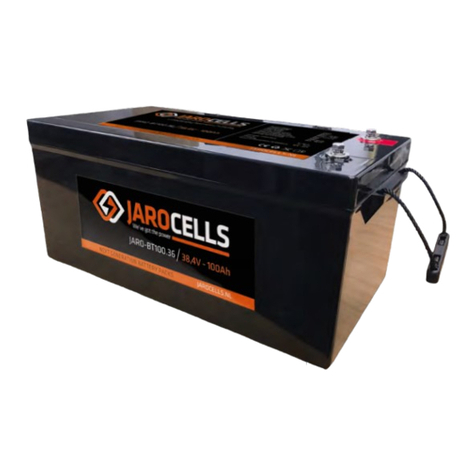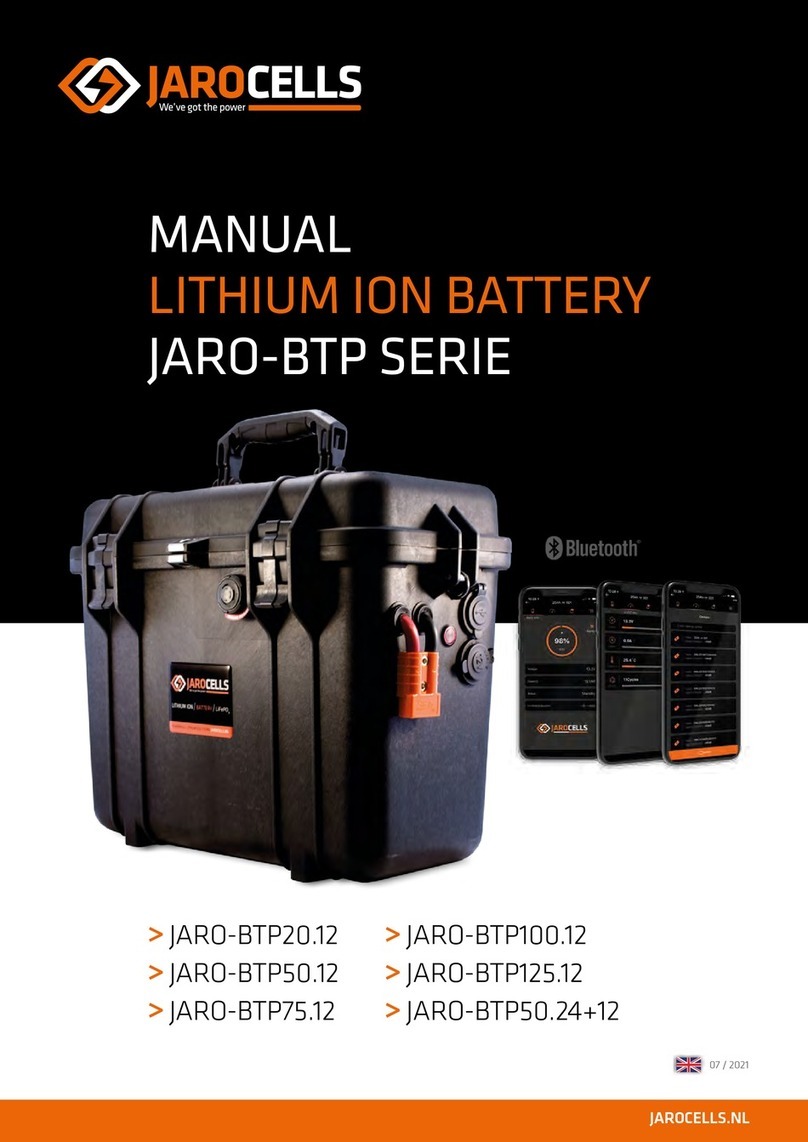
>Only a charger suitable for LiFePO4may be used to charge the battery.
>The battery must not be charged with damaged cables. Check this before charging the batteries.
>Use the charger in a dry environment. The charger should not come into contact with moisture unless it is a waterproof
charger.
>Rapid temperature changes can lead to condensation. If this happens, wait until the charger is dry and has assumed
the correct temperature of its environment.
>A JARO BT battery cannot be overcharged, is protected against over-discharging and will not be damaged when
completely discharged.
>When discharging, ensure that the maximum current remains within specifications. It is important that sucient
battery capacity installed to prevent operating outside specifications at maximum consumption. Although the battery
switches o at high current, this only happens after a certain time to be able to absorb peak currents. Working outside
the normal current range regularly will shorten the life of the battery.
>The battery has a self-discharge of 3 to 5% per month. This is of course faster with connected equipment.
Check the battery regularly for State of Charge (SOC) and charge it if the battery is less than 50% SOC or less than
12.8V (12V batteries) or 25,6V (24V batteries) or 38,4V (36V batteries).
>In case the battery is not used for a longer period of time it is recommended to disconnect all the equipment from the
battery to prevent discharge by e.g. monitoring instruments.
>The battery should not be charged when the temperature of the battery is below 0°C. Discharging the battery up to
-20°C is allowed. Since the battery temperature will increase during discharge, charging can be done directly after
discharge when the temperature is over 0°C.
>A fully discharged battery should be recharged within 24 hours. The loads will be disconnected automatically when the
battery is fully discharged but the remaining energy is minimal. Self-discharge can lead to damage of the battery when
the battery is left in fully discharged state for a longer period.
>Even if the battery is not completely discharged, it is recommended to fully charge the battery at least once a month
to recalibrate the internal measurements to ensure that the reading remains reliable.
Warning when used in parallel or series
>When used in parallel or series, the batteries must be in the same State of Charge (SOC). Charge the batteries
completely separately and then connect them in parallel or in series.
>When connected in series the batteries should be fully charged separately before connecting them (only 12V batteries
and not more than three in series).
>When placed in series the battery pack can be charged by using a 12V charger (dedicated LiFePO4charger or charged
programmed to the charging specifications) for each battery.
>Charging batteries connected in series with a 12V charger on each battery is allowed when the minus of the chargers
are not connected with each other directly or through ground. Consult an electrician or your supplier in case of doubt.
>No more than three 12V batteries may be connected in series. With 24V batteries the maximum is two in series (48V);
provided they are charged separately by 24V chargers. The 36V batteries may not be connected in series.
Warnings for transportation
>Transportation of the batteries should be done packed in the original packaging or a packaging suitable to protect the
battery against shock of falling on the ground.
>Make sure the batteries are fixed properly during transport to prevent shifting of the load.
>Avoid mechanical shocks such as knocks and falls.
5
MANUAL LITHIUM ION BATTERY JARO-BT SERIE



























